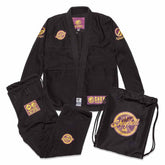Are Pull-Ups Good for BJJ? Benefits for Strength and Grip
Brazilian Jiu-Jitsu (BJJ) is often referred to as “the gentle art”. But any practitioner knows that it demands intense strength, control, and grip endurance. Among the many exercises incorporated into strength and conditioning routines for BJJ, pull-ups stand out as one of the most effective and essential. It never matters whether you are a beginner looking to build foundational strength or an advanced competitor seeking that extra edge. Pull-ups can be a game-changer for your performance on the mats.
In this comprehensive guide, we will explore why pull-ups are exceptionally good for BJJ. Moreover, how they directly impact grip strength and upper body control. Besides, we will explain how to integrate them effectively into your training.
Why Are Pull-Ups Important in Brazilian Jiu-Jitsu?
Functional Strength Over Aesthetic Strength
In bodybuilding, the goal is often appearance. However, BJJ requires functional strength. The strength that translates to controlling another person’s body, maintaining positions, and executing submissions. Pull-ups are a compound bodyweight movement that mirrors many BJJ actions, such as pulling your opponent’s collar, securing grips, defending takedowns, and executing sweeps or back-takes.
Mimicking BJJ Movements
The mechanics of a pull-up directly mirror many pulling motions in BJJ. Think about:
- Collar drags
- Pulling an opponent into your guard
- Breaking posture from closed guard
- Finishing a kimura or guillotine
Each of these actions demands pulling strength. Primarily from the latissimus dorsi, biceps, shoulders, and forearms, all muscles heavily activated during pull-ups.
Key Benefits of Pull-Ups for BJJ Athletes
1- Enhanced Grip Strength
Grip is arguably one of the most critical physical attributes in BJJ, especially for Gi practitioners. Pull-ups naturally require a strong grip. Particularly in hanging variations or towel pull-ups that mimic gripping a BJJ Gi. Regular pull-up training improves grip endurance. Thus, allowing athletes to hold onto sleeves, collars, and lapels for longer without fatigue.
Pro Tip: Use Gi sleeves, ropes, or towels over the bar when performing pull-ups to simulate Gi grips more realistically.
2- Improved Back and Arm Strength
BJJ is dominated by pulling mechanics. Thus, making upper back and arm strength essential. Pull-ups develop:
- Lats (for powerful pulling)
- Traps and rhomboids (for posture and balance)
- Biceps and forearms (for arm drags, takedowns, and submissions)
With stronger back and arm muscles, athletes can control positions better, execute submissions more effectively, and resist fatigue during scrambles or long rolls.
3- Core Activation and Control
Properly executed pull-ups engage the core stabilizers. Core strength is fundamental in BJJ for:
- Maintaining guard posture
- Bridging and hip escapes
- Positional transitions
Incorporating strict form and avoiding swinging not only boosts pulling strength. But it also reinforces the core i.e. a muscle group often underdeveloped in grapplers relying solely on mat time.
4- Body Awareness and Control
Pull-ups demand coordination, balance and rhythm. These are the qualities equally essential for BJJ. Regular practice improves:
- Proprioception (body awareness)
- Postural alignment
- Muscle control
This translates into smoother transitions, better base, and more efficient movements on the mat.
5- Injury Prevention
By strengthening the shoulders, scapula stabilizers, and posterior chain, pull-ups can help reduce the risk of injuries in BJJ. Many grapplers suffer from imbalances due to repetitive movements. Pull-ups offer a balanced way to strengthen opposing muscle groups and protect against overuse injuries.
Types of Pull-Ups and Their BJJ Applications
Standard Pull-Ups (Overhand Grip)
Target the upper back and lats. Thus, improving overall pulling strength. These are great for takedowns and guard pulls.
Chin-Ups (Underhand Grip)
More biceps engagement, helpful for submissions like the rear-naked choke or armbar finishes.
Towel or Gi Pull-Ups
Simulate Gi grip strength, enhancing sleeve and collar control.
Commando Pull-Ups (Side Grip)
Train asymmetrical strength—valuable for movements like arm drags or single-leg takedown finishes.
Archer Pull-Ups
Build unilateral strength. Thus, giving you better control in scrambles and when dealing with resistance from one side.
How to Integrate Pull-Ups into Your BJJ Strength Program
To get the most out of your pull-up routine for Brazilian Jiu-Jitsu, follow these best practices:
Frequency:
2–3 times per week is sufficient for most grapplers. Avoid overtraining, especially if you are rolling regularly.
Volume:
Start with 3–4 sets of 5–10 reps, depending on your current strength. Gradually increase volume or resistance over time.
Progressions:
- Assisted Pull-Ups with bands or machines
- Negatives (slow lowering)
- Weighted Pull-Ups for advanced grapplers
Variation:
Mix grip styles every week to hit different muscle groups and mimic diverse BJJ scenarios.
Guide > Best Home Workouts for BJJ Strength
Real-Life Testimonies: Why BJJ Black Belts Swear by Pull-Ups
Many elite BJJ practitioners and MMA fighters credit pull-ups as a foundational strength movement.
John Danaher is one of the most respected coaches in modern BJJ. He often emphasizes grip strength and pulling mechanics. Similarly, Roger Gracie, a 10-time world champion, has highlighted the importance of basic bodyweight strength, including pull-ups, in building a powerful grappling game.
According to a 2023 study published in the Journal of Strength and Conditioning Research, athletes who incorporated regular pull-up variations into their training showed a significant improvement in grip strength and reduced fatigue in grappling exchanges over a 6-week period.
Pull-Ups for Gi vs No-Gi BJJ
In Gi:
Pull-ups help simulate collar and sleeve grips, making them invaluable. Use a BJJ Gi wrapped around the pull-up bar to replicate realistic grip positions.
In No-Gi:
Grip strength still matters. But it is more about wrist control and underhooks. Regular pull-ups will enhance arm and back endurance. Thus, making it easier to maintain overhooks, underhooks, and wrist rides.
Common Mistakes to Avoid
- Using Momentum (Kipping) – Avoid CrossFit-style kips unless your goal is endurance. Controlled pull-ups are best for strength.
- Neglecting Full Range of Motion – Always aim to go from a dead hang to chin above the bar.
- Ignoring Grip Variation – Always change your grips to stimulate different muscles.
- Skipping Recovery – Like all exercises, pull-ups stress the joints. Allow recovery time, especially if you are rolling hard during the week.
Final Thoughts: Should You Do Pull-Ups for BJJ?
Absolutely. Pull-ups offer a low-tech, high-impact solution to many physical demands of Brazilian Jiu-Jitsu. It does not matter if you are rolling in Gi or No-Gi, competing or just training for health. The pull-up is one of the most bang-for-your-buck exercises you can do.
They improve grip strength, pulling power, body control, injury resilience, and functional athleticism. All of this translate directly to better BJJ performance. So if you are serious about becoming a well-rounded grappler, stop ignoring the pull-up bar. It is time to start making it a core part of your training regimen.







